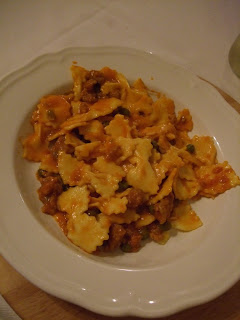 Ristorante Vecchio Falconiere in Padova looked like a great find. Accessed via a flowered bridge across a canal, it offered al fresco dining from a menu that promised reasonably priced pastas or, if we felt like going a little crazy, affordable, meaty mains.
Ristorante Vecchio Falconiere in Padova looked like a great find. Accessed via a flowered bridge across a canal, it offered al fresco dining from a menu that promised reasonably priced pastas or, if we felt like going a little crazy, affordable, meaty mains.But things aren't always as they seem. Rather than menus, our ebullient host brought a tray of pasta models to the table, and talked us through what was on offer, including the blueberry ravioli, or a mixed pasta plate if we liked (mixed entrees maybe, but what were they going to do? Bring it out on a dip tray?). Then, he drew up to his full height, puffed out his chest and said 'For main, I offer you my speciality. All the cuts of horse, cooked for you at the table.'
Call us staid, but we decided to stick with a la carte. We were rewarded for our lack of adventurous spirit, however. First up, the fusilli con cinghiale (wild boar, or wild pork as our host insisted).
This wasn't just any wild boar, but instead the cinta senese, a rare and ancient Tuscan pig represented in writings and art from the 14th century. (Good cured meat lasts a while, but I assume ours rummaged in the fields around Greve rather more recently than that.)
Fusilli in Australia, when bought as dried pasta, is normally shaped as a swirl. Freshly made, Italian fusilli, however, as you can see looks much more like someone took a length of pasta and rolled it over the table. Its curves were perfect for capturing the unctious ragu.
We also loved the tagliatelle con funghi misto, a dish of of rich, earthy variety.

 Our favourite restaurant discovery of the trip was Ristorante Nonna Ayeska in Ravenna, the main reasons for which will be elucidated in a coming post on cured meats. Their pasta was nothing to complain about either. The restaurant specialised in the local style of filled pasta, cappelletti, or little hats. These came con ragu or, as below, con vellutata di carciofi.
Our favourite restaurant discovery of the trip was Ristorante Nonna Ayeska in Ravenna, the main reasons for which will be elucidated in a coming post on cured meats. Their pasta was nothing to complain about either. The restaurant specialised in the local style of filled pasta, cappelletti, or little hats. These came con ragu or, as below, con vellutata di carciofi. 'Vellutata' literally means velvety, and I think it's a wonderful term to apply to the mush of artichoke that clung to the cheese-filled pasta.
'Vellutata' literally means velvety, and I think it's a wonderful term to apply to the mush of artichoke that clung to the cheese-filled pasta.A sauce of salsicce e piselli (sausage and peas), tried on different visits with both gnocchi and strichetti, was delicious, but lessened by the fact that the peas had been cooked in highly salted water, and that saltiness dominated the dish.

Strichetti is Emilia-Romagna's version of farfalle, and looks more like Chicken-in-a-Biscuit than bowties!
At Trattoria da Paccagnella in Padova we sampled some of the Veneto's favoured pastas. Most restaurants feature bigoli, a type of enlarged spaghetti, eaten here con sugo di gallina imbriaga, 'gallina' referring specifically to hen.
 The sugo, fittingly enough, tasted precisely like chicken soup.
The sugo, fittingly enough, tasted precisely like chicken soup.It was one of our last nights in Italy and I excitedly devoured a plate of strigoli con salsa di basilico.
 There are few greater pleasures than fresh pasta smothered in a zinging basil sauce (and all the better when it comes with garlic wedges like this!).
There are few greater pleasures than fresh pasta smothered in a zinging basil sauce (and all the better when it comes with garlic wedges like this!). The best food photo of the trip goes to SG's choice at Paccagnella:
The best food photo of the trip goes to SG's choice at Paccagnella: Ragu di vitello in bianco e fiori di zucca (twisted pasta in veal and white wine sauce with zucchini flowers).
Ragu di vitello in bianco e fiori di zucca (twisted pasta in veal and white wine sauce with zucchini flowers).At Paccagnella, house wine comes to the table in a bottle, and diners pay for a quarter, half or full bottle depending on how much they've drunk.
No comments:
Post a Comment